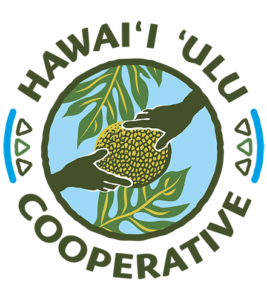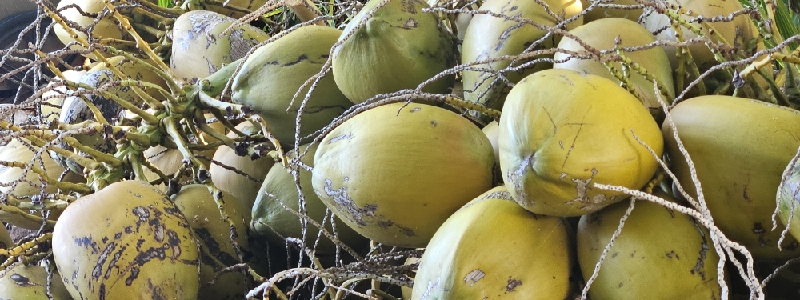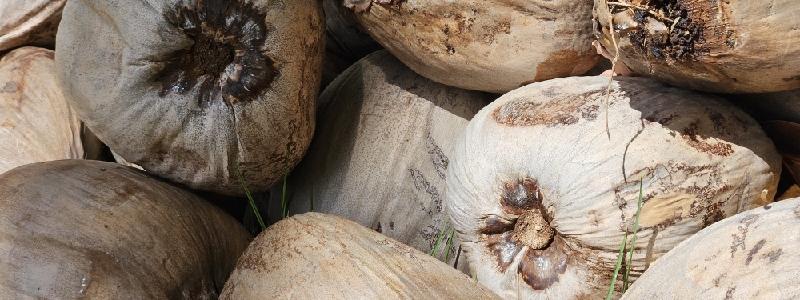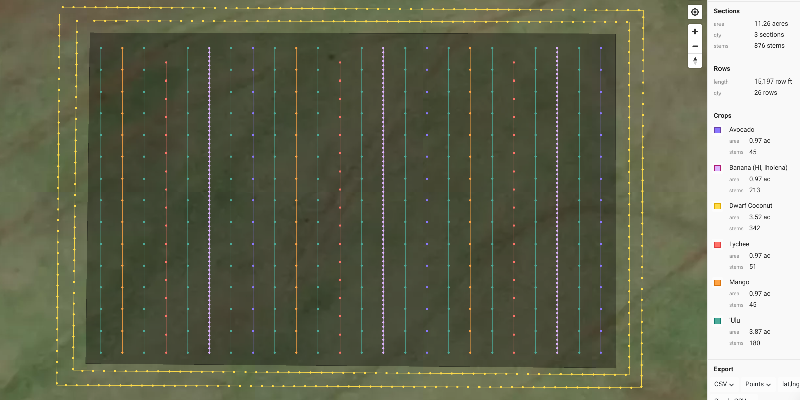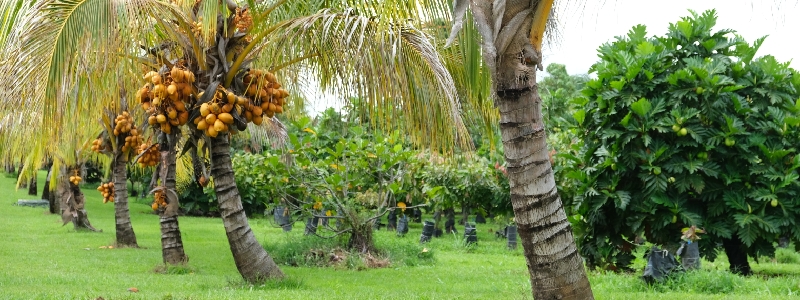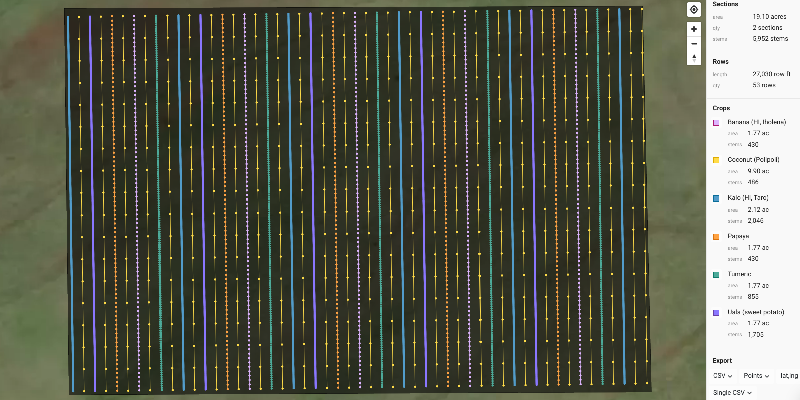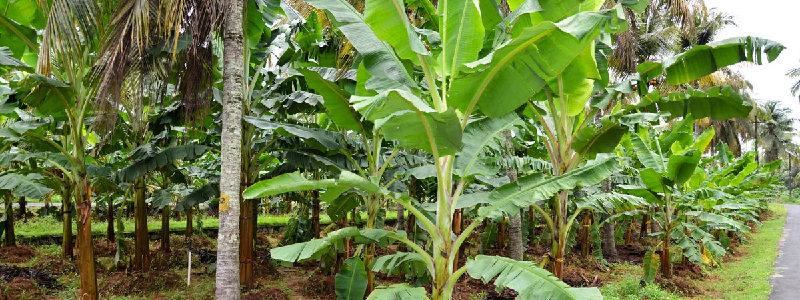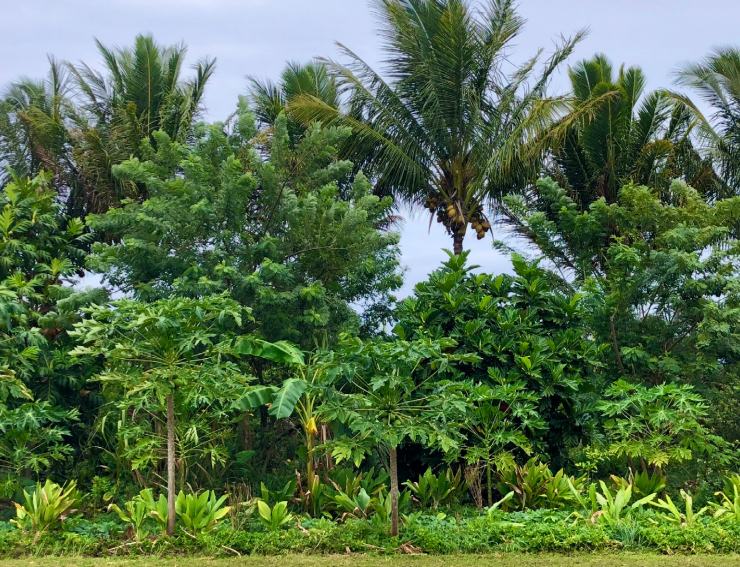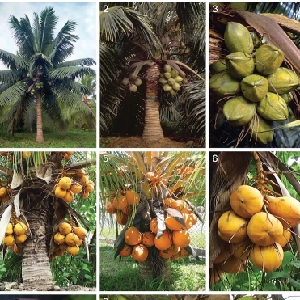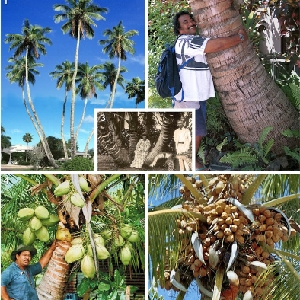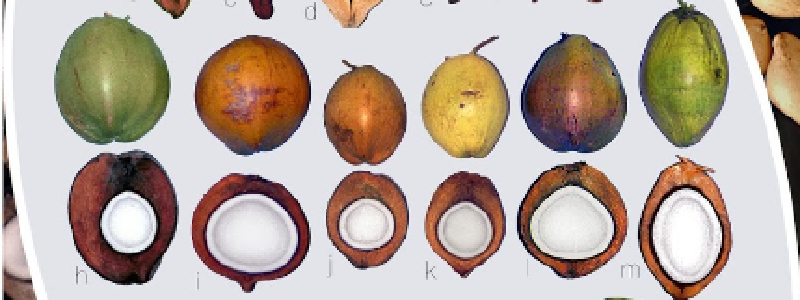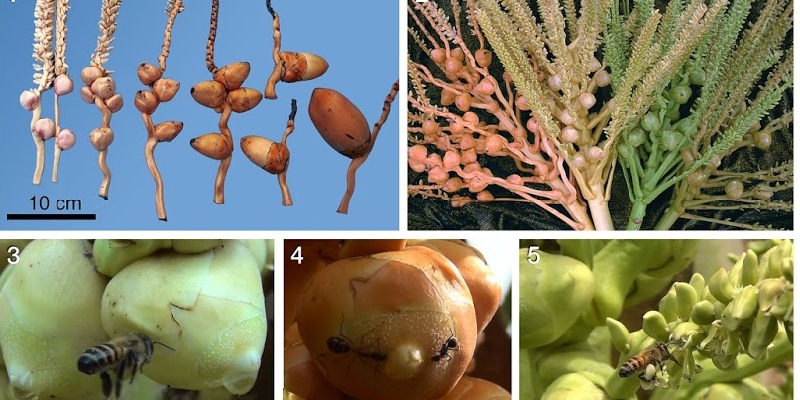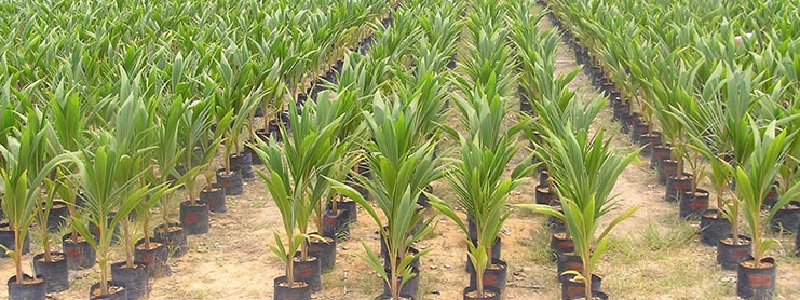Coconut Agroforestry – Part 2
The Niu Future
So how can we as growers support more local coconut production and benefit from all the amazing gifts this Tree of Life provides? Besides the food resource, there are many functions that coconut trees can provide in a modern agroforestry system, such as:
- Shade
- Windbreak
- Erosion control
- Water uptake in saturated areas
- Mulch and natural weed-mat
There are also many ways to integrate them depending on the goals of a system. Below are some of the things to consider when utilizing niu in establishing an agroforestry system.
Windbreaks & Perimeter plantings
One of the more common ways coconuts are planted today is to function as windbreaks or perimeter plantings similar to the layout below, where the yellow dots represent coconut trees. Since niu are very wind tolerant and develop broad canopies, in addition to producing a crop, they are a choice windbreak in suitable areas. For growers who want niu but don’t want them within their main production area for safety or some other reason, choosing to plant them exclusively on the edges of fields or property boundaries is a good strategy. To maximize the windbreak effect, niu should be planted 15-20 feet apart.
Alley-Cropping & Inter-Cropping
For growers who want to focus on coconuts as a main crop, like a more traditional Uluniu, a coconut based alley-cropping design could be established to maximize the number of coconut trees while also producing other crops between rows while the niu mature. The layout could look something like the image below where the Yellow dots represent coconut trees. Trees would generally be spaced 25-35 feet apart for this type of system.
Inter-cropping would be the integration of other crops grown all around, under or even on top of the coconut tree trunks as a natural trellis system – and not necessarily just within the alleys. There are many great examples of these systems around the tropical world.
Some benefits of this type of design would be:
- Niu provide wind and sun protection for other crops
- Alley crops provide yield and revenue in the early years while Niu are maturing
- Maximizes Niu production by utilizing a grid pattern across an area
Coconut plantations are also turning to different planting configurations to maximize coconut production and maintenance efficiency, such as the triangular grouping termed “G3PH”. For more info, check out this article on Niu planting configurations.
For a focused look at both of these agroforestry techniques, be sure to check out our Alley-Cropping & Windbreaks video.
Multi-Story Cropping
If a more diverse system that incorporates Niu to mimic a natural forest is the goal, then establishing a Food Forest should be considered. In this traditional type of system, Niu could be the emergent tree that provides both an overstory crop, as well as shade and protection for the crops below. The picture below from our ‘Ulu Agroforestry in Hawai’i Guide is a good example.
Considerations for Multi-Story cropping:
- High density creates high productivity across multiple crops, but can be labor intensive to manage harvesting
- High diversity creates healthy and resilient system, but harvest volume of any one crop is less than other systems
- Coconuts integrated into system create falling hazard for both people and crops below, and should be climbed routinely for harvest
- Density of plantings can often reduce weed maintenance to a minimum
For a more in-depth look at this traditional Polynesian agroforestry practice, be sure to watch our Multi-story Cropping video.
A traditional style Multi-story Cropping agroforestry system utilizing Breadfruit and Coconut trees
Selecting a Coconut Variety
When considering planting a substantial number of coconuts intended for production, varietal selection is a key factor. The variety grown affects things like: Tree height, time to maturity, nut size, oil content, environmental tolerances, and labor required to maintain and harvest.
In choosing what niu to plant, there are a few basics to understand…
Coconut varieties are often categorized generally as being either a “Tall type”, “Dwarf type”, or “Hybrid type”.
Tall:
- Can have higher oil content
- Generally more robust root system and more drought/pest tolerant
- Can be used as overstory crop in Multi-story cropping system
- Harder to harvest
- Takes longer until fruiting (6-10 years), but productive for longer (up to 60+ years)
- Tendency for cross-pollination
Dwarf:
- Easier to harvest
- Generally good for water nut production
- Quicker to fruit (1-3 years), but less productive lifespan (30+ years)
- More susceptible to drought/pest
- Tendency for self-pollination
Hybrid:
- A natural cross between Tall & Dwarf (usually by farmers selective pollinating)
- May produce more nuts per flowering
- May be quicker to yield than Talls
- May be more susceptible to extreme weather during early years
For a more in-depth look at Tall-type vs Dwarf-type coconuts, read more here.
Coconut seed diversity – Replant Coconut
Seednut Selection & Selective Pollination
One of the keystone presenters at the ʻAha Niu coconut conference was the renowned Dr. Roland Bourdiex who has spent the last 30+ years studying coconuts across 40 different coconut growing nations. Within his wealth of information, a key message he emphasized for farmers of coconut was the importance of practicing Selective Pollination in order to ensure true-to-type seed nuts for planting.
Coconuts are capable of self-pollination and also cross-pollination. This means that when a tree produces a coconut, it is not guaranteed to be “true-to-type” of what its mother tree is producing. It is often the case that it got cross-pollinated from a tree with different genetics than what is desired. And so if that seednut were planted, the coconuts it eventually produces will likely have different characteristics than those of it’s mother tree.
Since there is no known way to vegetatively reproduce coconut trees, seednut planting material is the only option. So in order to achieve desirable traits like early fruiting, true dwarfism, heavy producers, or specific coconut quality, it is essential to master variety selection.
You can learn some of the specific techniques for identifying quality seednuts that Dr. Bourdeix has picked up along his years of working with Niu farmers across the pacific. And for information on the more intricate practice of producing Hybrid varieties through Selective Pollination, check out this excellent video from the Deejay Coconut farm in India.
Male & Female flower parts – Replant Coconut
Hawaiʻi Niu Suppliers
Interested in specific coconut variety planting material? Look no further…
Below is a list of Hawai’i nurseries and suppliers doing the good work of perpetuating our Kumu Niu.
- Wai Kahe Coconut Farm (Hawai’i Island)
- Niuhui.org
- waikahenursery@gmail.com
- 808-300-8124
- Christopher Carter (Hawai’i Island)
- 808-557-4281
- NatureWorks Nursery (Maui)
- https://natureworksnursery.com/
- NatureWorksMaui@gmail.com
- 808-495-9605
- Makana (Kaua’i)
**This is a working list which we hope to add to. If you know a supplier of quality coconut planting material in Hawai‘i, please contact agroforestry@eatbreadfruit.com to be featured**
